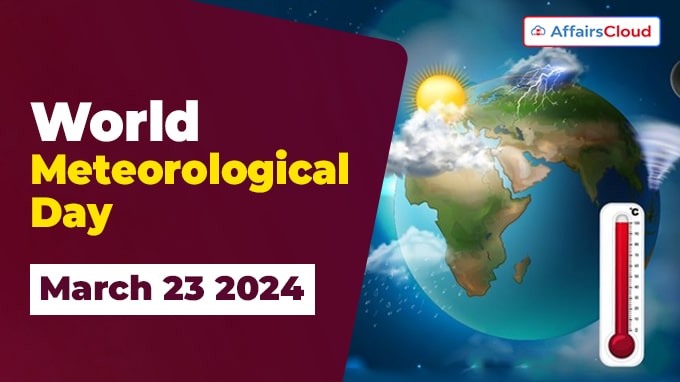 The United Nations (UN) World Meteorological Day (WMD) is annually observed across the globe on 23 March to raise awareness about weather, water, and climate-related issues, and about the Earth’s atmosphere and highlight individuals’ role in protecting it.
The United Nations (UN) World Meteorological Day (WMD) is annually observed across the globe on 23 March to raise awareness about weather, water, and climate-related issues, and about the Earth’s atmosphere and highlight individuals’ role in protecting it.
- Every 23 March, WMD commemorates the coming into force of the Convention establishing the World Meteorological Organization (WMO) on 23 March 1950.
The theme for World Meteorological Day 2024 is, “At the Frontline of Climate Action.”
- The themes chosen for WMD reflect topical weather, climate, or water-related issues.
Note: The 2024 theme recognises the threat posed by climate change and the growing role of meteorologists.
2024 Events:
Campaign:
i.In 2024, WMO partnered with the UN Development Programme (UNDP) and launched a climate action campaign on 21 March 2024 on television and social channels, to raise awareness globally and mobilize society to act.
- The message of the campaign was “If we all join together, we can keep the 1.5° degree ambition alive.”
ii.The campaign was supported by national meteorological and hydrological services, weather presenters, and media outlets around the world.
iii.A High-level panel discussion was held in Geneva, Switzerland, to discuss how to keep the 1.5° goal of the Paris Agreement alive.
WMO State of the Global Climate 2023 Report:
i.WMO’s annual report on ‘State of the Global Climate 2023’ was released on 19 March 2024, ahead of the World Meteorological Day (23 March 2024).
ii.The report unveils alarming trends in climate change, highlighting unprecedented challenges and urgent calls for action.
iii.Since 1993, the WMO, through the Commission for Climatology and in cooperation with its Members, has issued annual statements on the status of the global climate to provide credible scientific information on climate and its variability.
Key Facts:
Record-Breaking Climate Extremes:
i.Greenhouse gases (GHGs) levels, surface temperatures, ocean heat and acidification, sea level rise, Antarctic sea ice cover, and glacier retreat reached record highs in 2023.
- Concentrations of the three main GHGs – carbon
dioxide, methane, and nitrous oxide – reached record high.
ii.Heatwaves, floods, droughts, wildfires, and intensifying tropical cyclones disrupted millions of lives and incurred significant economic losses globally.
Warmest Year on Record:
i.2023 marked the warmest year on record, with a global average near-surface temperature of 1.45°C (with a margin of uncertainty of ± 0.12 °C) above the pre-industrial baseline.
- It was the warmest ten-year period on record.
ii.This temperature surge underscores the urgent need for climate action to mitigate further warming.
Oceanic Concerns:
i.On an average day in 2023, nearly one-third of the global ocean experienced marine heatwaves, threatening vital ecosystems and food systems.
ii.Towards the end of 2023, over 90% of the ocean had experienced heatwave conditions at some point during the year.
Glacial Meltdown:
Preliminary data revealed the largest loss of ice on record (since 1950) in the global set of reference glaciers, driven by extreme melt in western North America and Europe.
Renewable Energy Surge:
i.Despite the harsh climate outlook, Renewable energy generation, is primarily driven by solar radiation, wind, and water resources.
ii.In 2023, renewable capacity additions soared by almost 50%, reaching 510 gigawatts (GW), marking significant progress towards decarbonization goals.
Call to Action:
i.Climate leaders convened at the Copenhagen (Denmark) Climate Ministerial on 21-22 March 2024, to accelerate climate action.
ii.It emphasised the need to enhance Nationally Determined Contributions (NDCs) ahead of the February 2025 deadline and secure ambitious financing agreements at the Conference of the Parties 29 (COP29).
Note:
i.The COP 29 to the UN Framework Convention on Climate Change (UNFCCC) will take place in Baku, Azerbaijan from November 11–24, 2024.
ii.UNFCCC is the primary international, intergovernmental forum for negotiating the global response to climate change.
History:
i.WMO originated from the International Meteorological Organization (IMO), which was founded in 1873, in Vienna, Austria.
ii.On 23 March 1950, the World Meteorological Organization (WMO) was formally established.
iii.In 1951, WMO became the UN specialized agency for meteorology (weather and climate), operational hydrology, and related geophysical sciences.
Note: 2024 marks the 151st anniversary of the WMO’s predecessor, the IMO.
Background:
i.The WMO during its 12th session of the executive committee adopted the resolution Resolution 6 (EC-XII) and proclaimed the 23 March of every year as World Meteorological Day.
- The 1st ever WMD was observed on 23 March 1961.
Significance of WMD and WMO:
i.WMD highlights the role of the National Meteorological and Hydrological Services in societal safety.
ii.The UN World Meteorological Organization (WMO) provides the framework for international cooperation on weather issues.
WMO’s Societal Impact:
- Contributes to reducing hunger, and poverty, and improving health.
- Provides clean water, and energy, and protects biodiversity.
- Enhances climate resilience in cities and communities.
Climate Change Reality:
i.The average global temperature increased by over 1°C in 150 years due to heat-trapping greenhouse gases (GHGs).
ii.It resulted in extreme weather, warmer oceans, rising sea levels and glaciers, and melting ice.
iii.The Sustainable Development Goal (SDG) 13 commits to “take urgent action to combat climate change and its impacts.”
iv.Technological Advancements improved weather forecasts and early warnings.
About World Meteorological Organisation (WMO):
Secretary-General– Professor Celeste Saulo
Headquarters– Geneva, Switzerland
Established on– 23 March 1950
WMO Members– 193 Members, including 187 Member States and 6 Territories




